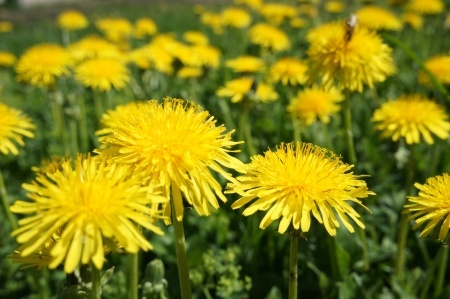
Spring Homestead Diet
From the Spring Equinox on March 21 the Sun is gradually gaining strength, bursting it’s powerful energy upon us. The day is claiming back it’s hours and becoming longer than night. For our ancestors, the days of Equinoxes, especially the Spring Equinox, were of universal importance. They were considered the turning points of Nature’s cyclic changes which affected each and every aspect of it. In all the traditions they were celebrated as sacred holidays and were often accompanied by spirit and body cleansing fasts. Also, it was the time to naturally switch away from the winter diet.
The symbol of Spring is rebirth. This powerful process affects us as well as the world around. We too are gradually emerging from the winter hibernation, feeling a bit drowsy after the long period of darkness. Eating heavy winter soups and stews that were helping us to stay warm and well nourished during cold months, we had inevitably accumulated some toxins. Awakened by the sun, our bodies begin to release them. To better understand how we can help ourselves to tune in with this universal process, let’s look at what Nature and our ancestor’s traditions have to offer.
And Nature is here to assist – strong, young spring shoots and leaves happen to be the most powerful body cleansers and antioxidants. Ramsons, wild leek, dandelions, nettle, spinach are the few of the available in abundance spring super greens. Our ancestors knew how to take full advantage of them and used them both as medicine and food. Their culinary traditions have many delicious ways of cooking spring garden as well as wild greens in salads, sautés, light spring soups, sauces or pie fillings. French, Italian, Georgian, East European, Native American cuisines – all have unique spring greens dishes.
In many traditions spring fasts were a good way to take a healthy break from heavy meat proteins. But, anyway, all homesteader’s diet naturally consisted of little meat in spring. It was time of lambing, freshening, farrowing and hatching for their farm animals. Instead of meat, light, easy digestible proteins such as eggs, milk and fresh cheeses were abundant in their spring diet, which was definitely a very beneficial switch for this time of the year. And, luckily, there were still some roots left in the homesteader’s cellars, as well as some grains.
It is not that difficult to implement this simple seasonal logic into our modern lives. We all need to cleanse and to lighten ourselves off a few extra winter pounds. Remarkably, naturally locally available spring foods offer us a complete and powerful cleansing diet. Nature is working in an amazing way, when all the solutions are simple and close.
Wild spring greens:
- Dandelions.
The king of spring greens. This most hated by lawn owners weed is here for purpose. It is chock full of vitamins A, B, C, and D, as well as minerals, such as iron, potassium, and zinc. It is the best herb for spring cleansing of liver and gallbladder and was used for thousands of years by Native Americans, Chinese, Europeans alike.
- Stinging nettle.
It is considered to be one of the best blood purifier in many herbal traditions. It stings, so do not touch it with bare hands and do not eat it raw. To collect young growth, use gloves and scissors. To chop it for cooking, dip it first in a boiling water for a minute or two. Young nettle shoots make the most delicious spring soup.
- Ramsons.
Wild garlic has been known as both medicine and food for thousands of years. It was used traditionally throughout Europe as a spring tonic due to its blood-purifying properties, as well as potent remedy to lower cholesterol. Forage for it in April – May in old woodlands. It may be used raw in salads or as a garnish to any spring dish, it may be cooked in any stew or soups, and may be used in homemade sauces like Pesto.
- Fiddle heads.
Fiddleheads are probably the coolest spring greens. They are young, unfolded shoots of ostrich fern. Depending on the weather, they begin to appear around late April to early May along river and stream banks, in wet areas and woodlands. They are harvested when just a few inches off of the ground so they are still tender and tightly coiled. They have a delicate green flavour. Fiddleheads may be steamed for 10 minutes, or sautéed. I usually keep them in boiling water for 3 minutes, strain, dry and quickly sauté in ghee. The tip is to not overcook. They are the best when didn’t loose their bright green colour and crispy texture. Do not forget to carefully remove brown scales and wash well under cold running water to remove dirt before cooking. If you are lucky enough to forage a lot of fiddleheads, freeze them for your winter special treat.
Garden spring greens:
- Spring rappini
- Spinach
- Beet greens
- Mustard greens
- Red and green leaf Roman lettuce
- Sorrel
- Scallions
References:
- Steven D. Ehrlich, NMD, VeriMed Healthcare Network. 6/22/2015
- http://www.naturescalendar.org.uk/
- The Seasonal Detox Diet. Carrie L’Esperance, Healing Art Press, 1998
